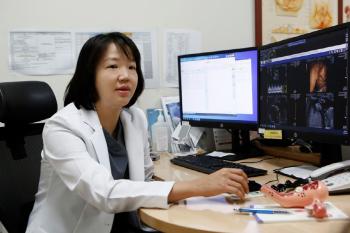The difficulty of ovarian cancer surgery can be predicted through vaginal ultrasound...Expect low-cost, customized treatment help
Nov 26, 2025
A study found that the difficulty of surgery and the degree of cancer spread in the abdominal cavity can be predicted only by vaginal ultrasound performed before ovarian cancer surgery.
The research team of Professor Seung-yeon Yoo of obstetrics and gynecology at Gangdong Kyunghee University Hospital and Professor Jongmin Lee proved that ultrasound images can accurately reflect the spread of cancer in the abdominal cavity, suggesting the possibility that vaginal ultrasound can be used as an indicator for predicting the difficulty of preoperative surgery. This study is significant in that it has established a new imaging basis to increase the 'complete resection rate', which is the core of ovarian cancer treatment. The results of the study were published in the latest issue of the European Journal of Surgical Oncology in 2025, a global journal in the field of surgical oncology.
Ovarian cancer has few symptoms early, and when cancer is detected, it has already spread to surrounding organs such as the peritoneum, intestines, and liver. The fundamental treatment is surgery, and the complete removal of cancer tissue determines the survival rate. The problem was that it was difficult to determine in advance how much cancer was spread in the abdominal cavity. CT or MRI tests were used to determine the spread of cancer, but small peritoneal metastases were often missed. Therefore, the need for more accurate imaging indicators to predict the degree of tumor spread before surgery has been steadily raised.
In response, Professor Seung-yeon Yoo and Professor Jongmin Lee's research team planned a study to see how accurately the highly accessible ' vaginal and rectal ultrasound' reflects the spread of tumors in the abdominal cavity to compensate for the limitations of existing imaging tests. The study was conducted by Gangdong Kyunghee University Hospital, Bundang Seoul National University Hospital, and Inha University Hospital as a multi-center joint study. The research team conducted an analysis of 101 patients scheduled for surgery for ovarian cancer, ovarian cancer, ovarian cancer, and peritoneal cancer at three hospitals from February 2022 to December 2023.
On vaginal or rectal ultrasound, the diffuse morphology of the Douglas and site tumors was classified as ▲none ▲ retinal nodule ▲ serosal ▲ mass and compared with peritoneal cancer index (PCI) and Pagotti score (prediction indicator of peritoneal cancer spread) evaluated during surgery. As a result of the study, the more severe the degree of dissemination on ultrasound, the significantly higher the PCI and Pagotti scores (p<0.05). In other words, it has been confirmed that the image of cancer seeding seen on ultrasound reflects how much cancer is actually spread in the stomach. This proved that it is possible to predict the difficulty of surgery or the possibility of requiring intestinal resection without CT or MRI.
This study is of great clinical significance in that it can indirectly evaluate the degree of proliferation of tumors in the abdominal cavity with ultrasound tests performed routinely before ovarian cancer surgery. It is expected to provide practical help in establishing customized surgical strategies for each patient because it has higher access to tests and less cost burden than CT or MRI. In addition, the patient group with cancer dissemination has about twice the intestinal resection rate than patients without cancer, so the evidence for preoperative ultrasound to determine whether the intestinal resection or the need for multidisciplinary cooperation was presented.
Professor Pyeon Seung-yeon said "Since ovarian cancer metastasizes extensively along the peritoneum, it is very important to accurately predict the extent of tumor spread before surgery" and "This study demonstrates that the difficulty of surgery can be predicted only by vaginal ultrasound images, so detailed diagnosis using ultrasound will be an important indicator for improving ovarian cancer treatment results in the future."
However, it is necessary to prepare large-scale follow-up studies and standardized ultrasound reading standards, noting that the number of patients was relatively small, the observation period was short, and that the results could vary depending on the skill level of the sonographer.
The research team of Professor Seung-yeon Yoo of obstetrics and gynecology at Gangdong Kyunghee University Hospital and Professor Jongmin Lee proved that ultrasound images can accurately reflect the spread of cancer in the abdominal cavity, suggesting the possibility that vaginal ultrasound can be used as an indicator for predicting the difficulty of preoperative surgery. This study is significant in that it has established a new imaging basis to increase the 'complete resection rate', which is the core of ovarian cancer treatment. The results of the study were published in the latest issue of the European Journal of Surgical Oncology in 2025, a global journal in the field of surgical oncology.
Ovarian cancer has few symptoms early, and when cancer is detected, it has already spread to surrounding organs such as the peritoneum, intestines, and liver. The fundamental treatment is surgery, and the complete removal of cancer tissue determines the survival rate. The problem was that it was difficult to determine in advance how much cancer was spread in the abdominal cavity. CT or MRI tests were used to determine the spread of cancer, but small peritoneal metastases were often missed. Therefore, the need for more accurate imaging indicators to predict the degree of tumor spread before surgery has been steadily raised.
In response, Professor Seung-yeon Yoo and Professor Jongmin Lee's research team planned a study to see how accurately the highly accessible ' vaginal and rectal ultrasound' reflects the spread of tumors in the abdominal cavity to compensate for the limitations of existing imaging tests. The study was conducted by Gangdong Kyunghee University Hospital, Bundang Seoul National University Hospital, and Inha University Hospital as a multi-center joint study. The research team conducted an analysis of 101 patients scheduled for surgery for ovarian cancer, ovarian cancer, ovarian cancer, and peritoneal cancer at three hospitals from February 2022 to December 2023.
On vaginal or rectal ultrasound, the diffuse morphology of the Douglas and site tumors was classified as ▲none ▲ retinal nodule ▲ serosal ▲ mass and compared with peritoneal cancer index (PCI) and Pagotti score (prediction indicator of peritoneal cancer spread) evaluated during surgery. As a result of the study, the more severe the degree of dissemination on ultrasound, the significantly higher the PCI and Pagotti scores (p<0.05). In other words, it has been confirmed that the image of cancer seeding seen on ultrasound reflects how much cancer is actually spread in the stomach. This proved that it is possible to predict the difficulty of surgery or the possibility of requiring intestinal resection without CT or MRI.
This study is of great clinical significance in that it can indirectly evaluate the degree of proliferation of tumors in the abdominal cavity with ultrasound tests performed routinely before ovarian cancer surgery. It is expected to provide practical help in establishing customized surgical strategies for each patient because it has higher access to tests and less cost burden than CT or MRI. In addition, the patient group with cancer dissemination has about twice the intestinal resection rate than patients without cancer, so the evidence for preoperative ultrasound to determine whether the intestinal resection or the need for multidisciplinary cooperation was presented.
Professor Pyeon Seung-yeon said "Since ovarian cancer metastasizes extensively along the peritoneum, it is very important to accurately predict the extent of tumor spread before surgery" and "This study demonstrates that the difficulty of surgery can be predicted only by vaginal ultrasound images, so detailed diagnosis using ultrasound will be an important indicator for improving ovarian cancer treatment results in the future."
However, it is necessary to prepare large-scale follow-up studies and standardized ultrasound reading standards, noting that the number of patients was relatively small, the observation period was short, and that the results could vary depending on the skill level of the sonographer.
|
This article was translated by Naver AI translator.














